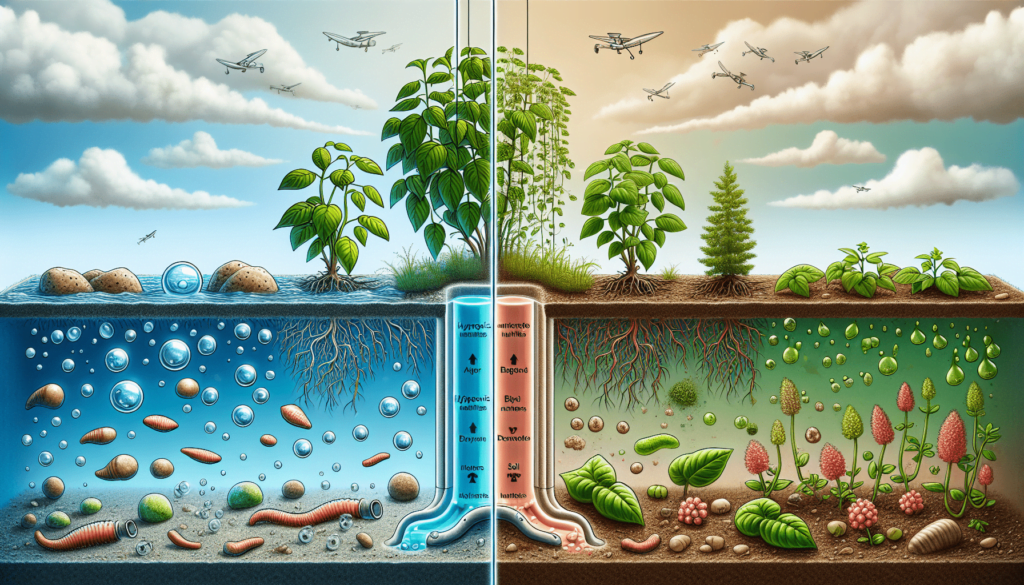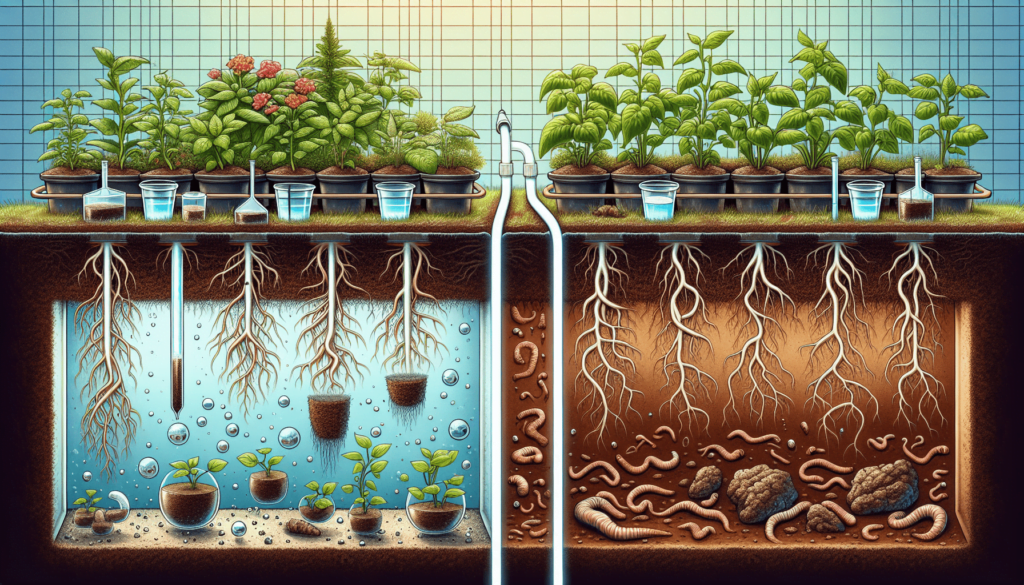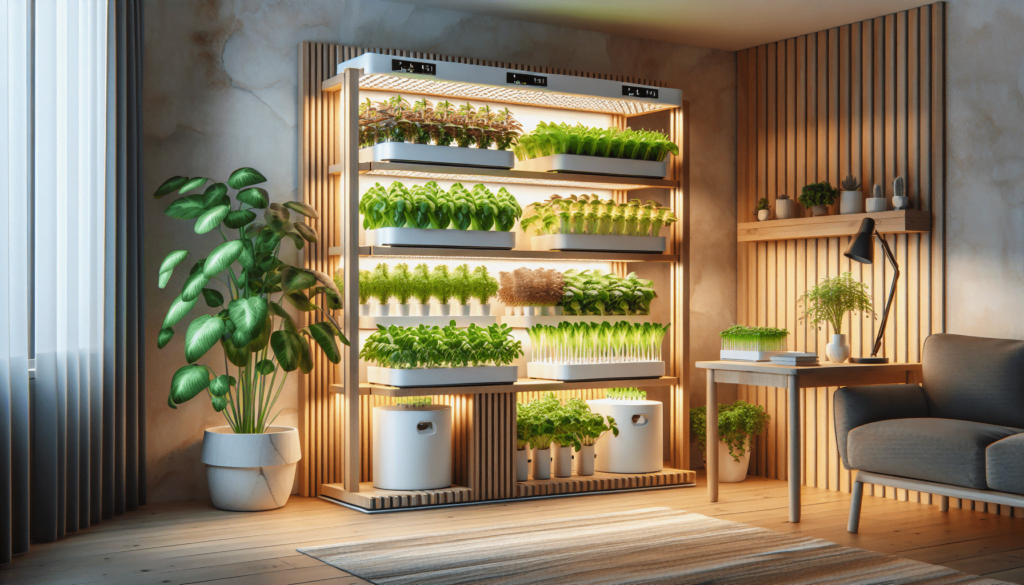Plant enthusiasts, we’ve got the perfect read for you to mushroom your knowledge in the gardening world. In this intriguing journey of “Understanding the Distinct Differences: Hydroponic Nutrients vs Soil Nutrients”, we’ll revolve around the puzzle of hydroponic and soil nutrients. You ever wonder why your hydroponically grown tomatoes burst with flavor as if they have tiny sunshine trapped inside, while the soil-grown ones often resemble, well, quite the opposite? Or why your crispy lettuce leaves seem to spring to life with pure enchantment when nurtured in water, as opposed to their soil counterparts? Well folks, it turns out, it’s all down to the nutrients these salad superheroes suck up from their environment. And we’re here to illuminate these nutritional conundrums for you.

Understanding Hydroponic Gardening
Defining hydroponic gardening
Ever wondered about trying your hand at gardening but felt limited by lack of space? Hydroponic gardening could be the answer you didn’t know you had! Hydroponic gardening, simply put, is the method of growing plants without soil. Yes, you heard that right – no soil! You see, we utilize a nutrient-rich solution that substitutes for soil, and the plants absolutely thrive in this water-based environment. It’s a revolutionary idea, isn’t it?
The importance of nutrients in hydroponics
Just as we can’t survive without a balanced diet, plants can’t thrive without their essential nutrients. In hydroponic gardening, it becomes even more critical. Since there is no soil to naturally provide these nutrients, they must be added into the water. These nutrients are like the pillars that uphold the plant, serving various functions to ensure healthy growth. They could be seen as the lifeline of these soil-less plants, don’t you think?
Common crops grown hydroponically
Hydroponic gardening sounds pretty fantastic, but you must be wondering what you can grow in such a system? Great question! Almost any leafy greens, herbs, and even fruits can be grown hydroponically. You’d be surprised to see how well tomatoes, lettuce, basil or even strawberries fare in a well-maintained hydroponic garden.
Insights into Traditional Soil Gardening
What is traditional soil gardening?
Remember the good old days when we used to get our hands muddy while playing in the garden? That, in essence, is traditional soil gardening – growing plants in soil, under the open sky, rain or shine. Planting seeds, nurturing them, and watching them sprout and blossom, it’s a timeless method that our forefathers have turned to for centuries.
Role of nutrients in soil gardening
Just like in hydroponics, nutrients play a central role in soil gardening too. The soil is more than just a place for plants to root; it’s their personal chef, serving up a nutritious meal every day. The nutrients in the soil promote plant growth, aid in seed germination, and support overall plant health. So, much like us, plants too need their daily gourmet fix to flourish!
Typical crops for soil gardening
“What crops grow best in soil?” – you may ask. Well, the soil is pretty accommodating and can house a range of plants. From root vegetables like carrots and beets to fruits like apples and berries, from leafy greens like spinach to herbs like mint, soil gardening promises a colourful and bountiful harvest.
Contrasting Hydroponic and Soil Gardening Techniques
Comparative discussion on watering methods
Watering is where the major differences between hydroponic and soil gardening techniques truly delineate. While soil gardening is pretty much about maintaining moisture levels, hydroponics takes a different approach. Rather than intermittently supplying water, the roots in a hydroponic garden are constantly exposed to a water and nutrient mix. So it’s a bit like a marathon versus a sprint, isn’t it?
Key differences in nutrient delivery
In soil gardening, the nutrients are already present in the soil, and the plant roots actively seek them out. But in hydroponics, the nutrients come delivered door-to-door to the roots. This lavish treatment, no doubt, helps the plants grow faster and healthier. Isn’t it like getting gourmet meals home-delivered versus hunting for food in the wild?
Impact on crop yield and growth speed
With hydroponics, crops often grow faster and yield more because the plants don’t waste energy searching for nutrients or water. They’ve got it all at their disposal, you see! However, soil gardening has its charm too – the slower pace, the joy of working with earth and watching life sprout forth. But hey, in terms of speed and yield, hydroponics has quite the edge, doesn’t it?
Delving into Hydroponic Nutrients
Understanding what hydroponic nutrients are
So, what exactly are these hydroponic nutrients we’ve been talking about? Well, they are a specially formulated mix of essential elements that your plants need to grow without soil. It’s like a ‘meal replacement’ shake, packed with all the good stuff for your plants to get their nutrition strictly from water.
Types of hydroponic nutrients
Hydroponic nutrients can be majorly categorized into macro and micronutrients. Macronutrients are the nutrients plants need in large amounts, like Nitrogen, Phosphorus, and Potassium, while micronutrients, needed in smaller quantities, include elements like Iron, Manganese, Zinc. Don’t they sound like superheroes who’ve got your plants’ back?
How hydroponic nutrients affect plant growth
Just like how vitamins and minerals play distinct roles in our body, so do these nutrients in plants. They accelerate growth, ensure healthy root development, enhance the fruiting and flowering process – the list goes on. Not getting enough of any one nutrient can hamper your plant’s growth. It’s like juggling balls in the air; you drop one, and the act falls apart!

Unraveling the Composition of Soil Nutrients
What comprises soil nutrients
So, if the soil is a chef serving up the best meal for the plants, what’s on the platter? Soil is a complex mix of macro and micro-nutrients. It doesn’t just contain Nitrogen, Phosphorus, and Potassium (the major nutrients), but also a variety of micronutrients that contribute to various facets of plant development. It’s like a buffet with a variety of dishes – each adding to the overall nourishment!
Different types of soil nutrients
As we mentioned earlier, the soil buffet table is pretty elaborate. In addition to the N-P-K main course, it offers Calcium, Magnesium, and Sulphur. But wait, there’s more! Soil also contains trace elements like Iron, Manganese, Copper, Zinc, Molybdenum, and Boron. That’s quite the spread, don’t you agree?
Impact of soil nutrients on plant development
Now that we know what that buffet contains, let’s see why these nutrients are fundamental. They’re not simply about growth; they contribute to plant reproduction, help them fend off diseases, aid photosynthesis and even help balance the plant’s internal pH levels. Without a doubt, soil nutrients are essential for a plant’s happy and healthy life.
Essential Nutrients Required for Plant Growth
Macronutrients and why plants need them
Unfortunately, plants can’t communicate about their dietary needs like we do. But trust us, they demand a healthy serving of macronutrients – Nitrogen for producing foliage, Phosphorus for strong roots, Potassium for all-round health, and Calcium, Magnesium and Sulphur hyping up general plant vitality. They might not say it, but they definitely need it!
The role of micronutrients
Micronutrients might play second fiddle to the macronutrients, but don’t underestimate their value. They’re like the supporting cast that makes the movie shine. From aiding photosynthesis to contributing to enzyme functions, they’re essential for healthy plant growth. After all, every character is vital for a blockbuster movie, right?
Vital elements shared by both soil and hydroponic nutrients
While soil and hydroponic gardening might seem worlds apart, their nutrient needs present a common ground. Both demand a balance of macro and micronutrients, indicating that no matter the medium, the nutritional requirements of plants remain steady. To put it simply, the plant’s diet remains the same; it’s just the dining table that changes!
Hydroponic Nutrient Solutions vs Soil Nutrient Make-up
Comparative breakdown of nutrient contents
When comparing nutrient contents, hydroponic nutrients come pre-packaged, tailor-made for the plants, while soil nutrients are inherently part of the soil composition. Soil nutrients rely on the organic materials and minerals within the soil, while hydroponic nutrients are mixed into the water. It’s almost like comparing a home-cooked meal to a scientifically created meal supplement!
How nutrient absorption differs in both systems
In soil, plants need to ‘search and absorb’ their nutrients. It’s a bit like hide and seek, where the roots hunt for the nutrients. In contrast, hydroponic nutrients are readily available, eliminating the need for plants to expend energy for nutrient absorption. It’s the difference between seeking your meal versus having it served on a platter!
Understanding nutrient lock-out in both systems
Ever heard of a situation where plants can’t absorb the nutrients available to them? That, my friend, is called nutrient lock-out, and yes, it can occur in both systems. It normally happens when the pH level is off or there’s an imbalance of nutrients. Sort of like a ‘No Entry’ sign that prevents your plants from dining at their nutrient buffet!
Effect of Hydroponic and Soil Nutrients on Crop Quality
How hydroponic nutrients influence crop quality
Hydroponic nutrients are often credited for the superior quality of the crop. With balanced nutrients available round the clock, the plants develop robustly. They grow faster, yield more, and often taste better. It’s safe to say that the hydroponic nutrient solutions often serve as a secret ingredient for your crops to flourish!
Impact of soil nutrients on crop quality
On the other hand, soil nutrients offer a slower, more natural growth. While it might not match up to hydroponics in terms of yield, soil-grown crops often have a distinct taste and aroma that’s loved by many. Isn’t it wonderful how the soil adds its unique touch to the crops?
Comparative analysis of crops grown on both systems
Comparing the crop quality of both systems, one might find hydroponic crops often outshine soil-based ones in terms of yield and growth speed. But soil-grown crops often score on taste and aroma. Isn’t it fascinating that the same plant could offer different experiences based on how it’s nurtured?
Adjusting Nutrients for Optimal Plant Health
How to measure and adjust nutrient levels in hydroponics
In hydroponics, the key is to constantly monitor and adjust the nutrient levels. Most hydroponic nutrients come with instructions about dosage but observing your plants can provide custom insights. A nutrient testing kit can effectively gauge the nutrient pH or Electrical Conductivity levels – sounds like a science experiment, doesn’t it?
Tips for maintaining soil nutrient levels
Keeping soil nutrient levels in balance can be a bit tricky. Regular soil testing, balanced organic fertilizing, and using compost can maintain good nutrient levels. It’s a bit more traditional, a bit more hands-on, but immensely rewarding!
Signs of nutrient deficiency in plants
Stunted growth, yellowing or browning leaves, weak stems – these are your plants’ SOS signals, indicating they’re lacking certain nutrients. Each symptom can be associated with a specific nutrient deficiency. Fascinating, isn’t it? So, plants do have a way to communicate!
Striking a Balance: Combining Hydroponic and Soil Nutrients
Possibility of integrating hydroponic and soil nutrients
Now, this might sound like a crazy sci-fi idea, but imagine if we could integrate hydroponic and soil nutrients? It’s not entirely impossible, as some components of hydroponic solutions can be beneficial for soil-based plants as well, especially for indoor plants or those in nutrient-poor soils. That would be like availing the benefits of two worlds!
Tips for a successful integration
But before you start mixing, it’s important to test and adjust. Consider starting with a small percentage of hydroponic nutrient mix into your soil and monitor closely for any changes. Remember, when it comes to nutrients, it’s very much a game of balance and precision.
Expected results and benefits of using combined nutrients
With combined nutrients, one could potentially get the best of both worlds: nutrient-rich hydroponics and the distinct flavors from the soil. Wonders could happen if experimented right, don’t you think?
Let’s remember that plants, just like us, have specific dietary needs. Irrespective of whether it’s soil or water, let’s make sure they get the best buffet of nutrients they deserve. After all, with the right care and love, both soil and hydroponic gardening can yield bountiful and satisfying harvests. So, ready to get started on curating your perfect nutrient mix?
Related Products…
-
%27%20fill-opacity%3D%27.5%27%3E%3Cpath%20fill%3D%22%23f8f5ff%22%20fill-opacity%3D%22.5%22%20d%3D%22M343.4%20113v187.6h-88V113z%22%2F%3E%3Cellipse%20fill%3D%22%23000005%22%20fill-opacity%3D%22.5%22%20rx%3D%221%22%20ry%3D%221%22%20transform%3D%22matrix(4.87453%20-59.9926%20284.9041%2023.14908%2082%208.5)%22%2F%3E%3Cellipse%20fill%3D%22%23f1f3e0%22%20fill-opacity%3D%22.5%22%20rx%3D%221%22%20ry%3D%221%22%20transform%3D%22matrix(-23.73813%20113.62803%20-50.24658%20-10.49706%201%20239.2)%22%2F%3E%3Cellipse%20fill%3D%22%23889a27%22%20fill-opacity%3D%22.5%22%20rx%3D%221%22%20ry%3D%221%22%20transform%3D%22matrix(-64.78446%20-53.49559%2030.51057%20-36.94904%2094.2%20194.5)%22%2F%3E%3C%2Fg%3E%3C%2Fsvg%3E) 2.2 lb General Hydroponics MaxiGro Plant Food Promotes Vigorous Growth$15.99
2.2 lb General Hydroponics MaxiGro Plant Food Promotes Vigorous Growth$15.99 -
%27%20fill-opacity%3D%27.5%27%3E%3Cellipse%20fill%3D%22%23e3cde9%22%20fill-opacity%3D%22.5%22%20rx%3D%221%22%20ry%3D%221%22%20transform%3D%22rotate(170.2%2041.8%2017.4)%20scale(298.82813%2042.59001)%22%2F%3E%3Cellipse%20fill%3D%22%234ea41b%22%20fill-opacity%3D%22.5%22%20rx%3D%221%22%20ry%3D%221%22%20transform%3D%22matrix(-69.90753%201.82387%20-4.33172%20-166.03164%20270.4%20218)%22%2F%3E%3Cellipse%20fill%3D%22%23c2417b%22%20fill-opacity%3D%22.5%22%20rx%3D%221%22%20ry%3D%221%22%20transform%3D%22matrix(-58.94836%20-.01314%20.04946%20-221.91372%2039.4%20260.6)%22%2F%3E%3Cellipse%20fill%3D%22%23383f50%22%20fill-opacity%3D%22.5%22%20rx%3D%221%22%20ry%3D%221%22%20transform%3D%22matrix(-26.1675%20-.27404%201.09104%20-104.18296%20145.9%20247.8)%22%2F%3E%3C%2Fg%3E%3C%2Fsvg%3E) Trial Pack of General Hydroponics FloraSeries Hydroponic Nutrient Fertilizer System – Includes FloraMicro, FloraBloom, and FloraGro, 1 qt$35.69
Trial Pack of General Hydroponics FloraSeries Hydroponic Nutrient Fertilizer System – Includes FloraMicro, FloraBloom, and FloraGro, 1 qt$35.69 -
Product on sale
 Hydroponic Nutrients Set (800ml Total), Hydroponic Plant Food A & B, Indoor Plant Fertilizer for Hydroponic Growing Systems, Growing System Accessories for VegetablesOriginal price was: $14.99.$10.49Current price is: $10.49.
Hydroponic Nutrients Set (800ml Total), Hydroponic Plant Food A & B, Indoor Plant Fertilizer for Hydroponic Growing Systems, Growing System Accessories for VegetablesOriginal price was: $14.99.$10.49Current price is: $10.49.
Forum
Got something to share or a question to ask? Jump in and start a conversation! Whether it’s tips, advice, or just sharing your experiences, we’d love to hear from you. Don’t be shy—your input could inspire or help someone else!- This forum has 1 topic, and was last updated 7 months, 1 week ago by .
- Topic
- Voices
- Last Post
- You must be logged in to create new topics.
Register Here
Forum
Got something to share or a question to ask? Jump in and start a conversation! Whether it’s tips, advice, or just sharing your experiences, we’d love to hear from you. Don’t be shy—your input could inspire or help someone else!- This forum has 1 topic, and was last updated 7 months, 1 week ago by .
- Topic
- Voices
- Last Post
- You must be logged in to create new topics.





